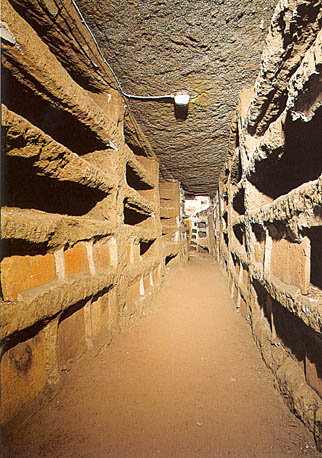 During the second day of orientation, I was able to visit the catacombs of Priscilla, one of many catacombs in Roma, but only a few of which are open to the public. The catacombs held, at one point, around 40,000 bodies. There are around 8 miles of underground tunnels which contain the tombs, some of which have not been opened.
During the second day of orientation, I was able to visit the catacombs of Priscilla, one of many catacombs in Roma, but only a few of which are open to the public. The catacombs held, at one point, around 40,000 bodies. There are around 8 miles of underground tunnels which contain the tombs, some of which have not been opened.This was also the burial place of many early Christians, including martyrs and even a few popes. The catacombs of Priscilla are names as such because of the woman whose property it was. Priscilla eventually donated the land to the Church to be used as a burial place. As more people died, more space was needed to properly bury these individuals, and so the Romans dug deeper to house them all—thus leaving the multi-level catacombs which can still be seen today. Within the catacombs, there are many beautiful frescos and images carved into rock, marble, or brick. Most noteworthy is the oldest known image of Our Lady, which is immaculately preserved, considering the conditions and age of the fresco.
 The most inspiring aspect of the catacombs is, in fact, the many martyrs and faithful Christians who have been buried there over the years. Within the catacombs stand altars, which have been used for millennia by the earliest Christians. For years, followers of Christ in Rome celebrated the Holy Mass in the exact same spot, and we as a class were able to carry on that celebration. During that mass, the Rev. Monsignor gave a consoling homily on the topic of suffering and sacrifice. He mentioned that the martyrs, obviously, encountered much suffering and sacrifice in their lives as a result of following Christ. We, too, must do the same. We are a class that has given up much to be studying in Rome. We have sacrificed family, friends, and many familiarities back home for a new adventure in a foreign, often uncomfortable way of life. It’s not easy to give up the familiarity of Milwaukee, Wisconsin in order to pursue Christ in a foreign world. Yet, I have two options. I could mourn the sacrifice made, which might only amplify the situation and produce little to no benefit. Or, I could surrender the sacrifice of family, friends, and everything else contained in the life left behind, and offer it for the Lord to sanctify. God can make holy all that we surrender to Him. Thus, when I encounter times of suffering and sacrifice, although miniscule in comparison to the trials of the martyrs, I surrender it to Christ, that He might make it holy and sanctify it.
The most inspiring aspect of the catacombs is, in fact, the many martyrs and faithful Christians who have been buried there over the years. Within the catacombs stand altars, which have been used for millennia by the earliest Christians. For years, followers of Christ in Rome celebrated the Holy Mass in the exact same spot, and we as a class were able to carry on that celebration. During that mass, the Rev. Monsignor gave a consoling homily on the topic of suffering and sacrifice. He mentioned that the martyrs, obviously, encountered much suffering and sacrifice in their lives as a result of following Christ. We, too, must do the same. We are a class that has given up much to be studying in Rome. We have sacrificed family, friends, and many familiarities back home for a new adventure in a foreign, often uncomfortable way of life. It’s not easy to give up the familiarity of Milwaukee, Wisconsin in order to pursue Christ in a foreign world. Yet, I have two options. I could mourn the sacrifice made, which might only amplify the situation and produce little to no benefit. Or, I could surrender the sacrifice of family, friends, and everything else contained in the life left behind, and offer it for the Lord to sanctify. God can make holy all that we surrender to Him. Thus, when I encounter times of suffering and sacrifice, although miniscule in comparison to the trials of the martyrs, I surrender it to Christ, that He might make it holy and sanctify it.
